Part 2: Financial trends and financial information
2.1
In this Part, we have used the financial information from the 2015-25 LTPs (the latest LTPs) to answer the following questions:
- Are local authorities planning major changes to their spending patterns?
- Are local authorities planning to look after their major assets?
- Are local authorities planning reasonable and justified rates increases?
- What rates limits are local authorities imposing in the future?
- Are local authorities still focused on prudent debt management?
- Did local authorities set effective limits on their forecast debt levels?
- What else are local authorities telling their communities?
2.2
LTPs contain a wealth of financial information. We have focused on the picture that emerges when this information is considered for all local authorities as a sector.1 Where appropriate, we describe trends in the 2015-25 LTPs and compare them to trends that emerged from the previous LTPs.
2.3
It is important to note that the data for the 2012-22 LTPs (the previous LTPs) did not include Christchurch City Council. Legislation enacted after the Canterbury earthquakes gave Christchurch City Council an option, which it took, not to prepare and adopt an LTP for 2012-22.
Are local authorities planning major changes to their spending patterns?
2.4
The total expenditure of all local authorities is set to increase by 34% between 2015 and 2025. Total expenditure for 2012/13 was $7.9 billion and for 2013/14 $7.8 billion. We have not yet collated the total expenditure for 2014/15.
2.5
The average year-on-year increase in total expenditure is 3.3%.2 This is below the year-on-year movement of 4% that was forecast in the previous LTPs. Figure 1 shows all local authorities' forecast total operating expenditure as set out in the previous LTPs and current LTPs.
Figure 1
All local authorities' forecast total operating expenditure, 2012-22 and 2015-25
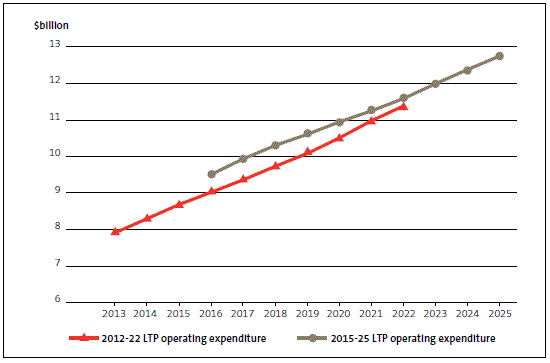
Source: Data collated by our office from information available in long-term plans.
2.6
Total operating expenditure is made up of four items: employee costs, interest expense, depreciation and amortisation, and other operating expenditure. We compared the breakdown of total spending in the previous LTPs with the breakdown in the latest LTPs. The differences were small. This shows local authorities' expenditure in the current LTPs is following a similar spending pattern to previous LTPs.
Are local authorities planning to look after their major assets?
2.7
Local authorities plan to spend $41.6 billion on capital works between 2015 and 2025.3 The average annual spending on capital is forecast to be $4.2 billion, compared to $3.7 billion in the previous LTPs (which excludes Christchurch City Council).
2.8
This forecast spending is made up of $8.2 billion to meet additional demand (19%), $13.2 billion to improve levels of service (32%), and $20.2 billion to renew and replace existing assets (49%). In the previous LTPs, the planned spending was $36.8 billion to 2021-22, made up of $7.1 billion (19%) to meet additional demand, $14.7 billion (40%) to improve levels of service, and $15.0 billion (41%) to renew and replace existing assets. The notable change in the latest LTPs is an 8% decrease in spending on improving levels of service and a corresponding increase in forecast spending on renewing and replacing existing assets. Figures 2 and 3 show local authorities' total spending on capital by category, as set out in the 2012-22 and 2015-25 LTPs.
Figure 2
Local authorities' total forecast spending on capital, 2015-25, by category
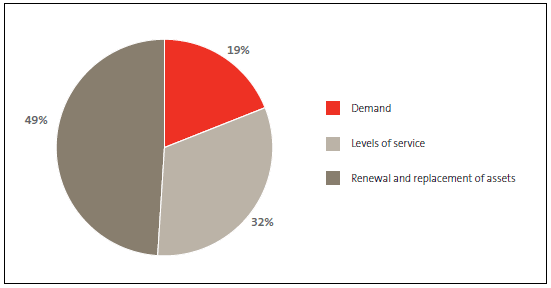
Note: Figure 2 includes Christchurch City Council's forecast total spending on capital.
2.9
When the current LTP spending on capital is adjusted to exclude Christchurch City Council, the total spending is $37 billion, which is the same as in the previous LTPs for 2012-22.
Figure 3
Local authorities' total forecast spending on capital, 2012-22, by category
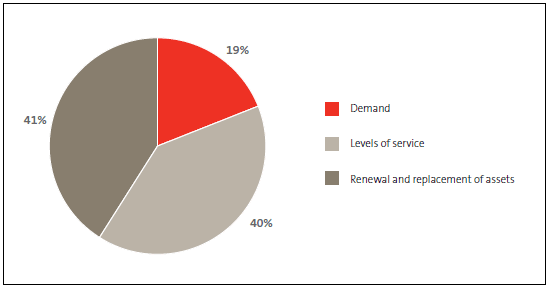
Note: Figure 3 excludes Christchurch City Council's forecast total spending on capital.
2.10
The consistent level of spending on capital is not unexpected, because changes in asset management planning are more likely to be about the spending between asset categories and timing than a reduction in overall spending. In Part 4, we discuss the capital expenditure trends in the 20 years beyond the 10-year LTP period.
2.11
In our previous reports, we considered in detail the link between spending on capital for renewing and replacing existing assets and the provision for that replacement through depreciation. We have compared renewals spending to depreciation on the basis that depreciation is a reasonable estimate of the consumption of the service potential inherent in the asset.4
2.12
When we compare the spending on capital as forecast in the previous LTPs with that forecast in the latest LTPs, it is clear that an increasing proportion of total spending is being directed towards renewal of infrastructure assets. However, as Figure 4 shows, although there is an increase in the level of renewal and replacement spending compared to depreciation in 2015, from 2019 onwards the level returns to almost mirror the level forecast in the previous LTPs. We note that a large amount of the increase relates to Christchurch City Council rebuild work.
Figure 4
Forecast annual renewals as a percentage of forecast depreciation
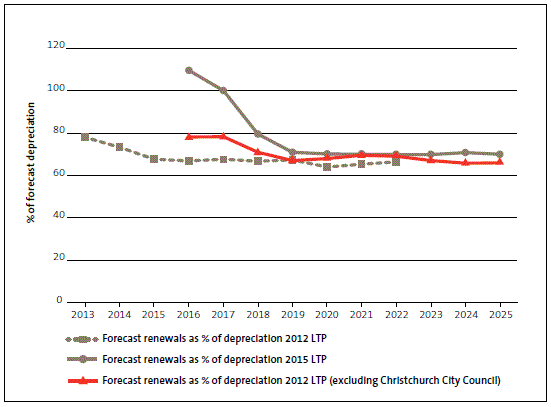
Source: Data collated by our office from information available in long-term plans.
2.13
In the previous LTPs, many local authorities proposed a "just in time" approach to renewals as a way of reducing overall spending on infrastructure. The latest LTPs have an increasingly realistic approach to the need to spend money on renewing infrastructure assets. Several local authorities presented plans to address what they now acknowledge as a "backlog" of renewals spending.
2.14
Individual local authorities need to consider whether the renewal and replacement spending they have forecast for 2019 onwards is adequate or will need to be increased when the next LTPs are produced in 2018. Local authorities will need to examine the detailed information they hold about their assets. It is not possible for us to assess this using the information that we hold. We considered the renewal and replacement capital expenditure to depreciation relationship for the five main groups of infrastructure assets. Figures 5-9 show the forecast depreciation expense (which reflects the estimated asset consumption) and the forecast renewal and replacement capital expenditure over the period of the LTP.
Figure 5
Forecast renewal and replacement capital expenditure on roads and footpaths and related depreciation

Source: Data collated by our office from information available in long-term plans.
Figure 6
Forecast renewal and replacement capital expenditure on sewerage and the treatment and disposal of sewage and related depreciation
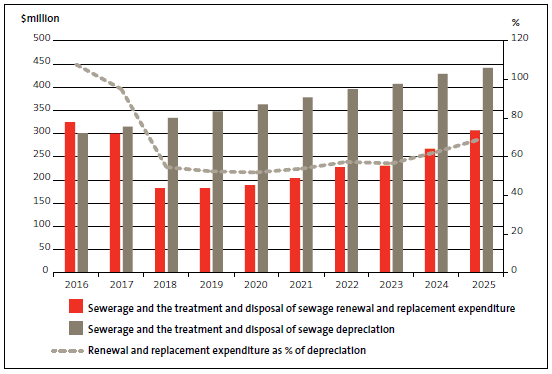
Source: Data collated by our office from information available in long-term plans.
Figure 7
Forecast renewal and replacement capital expenditure on water supply and related depreciation
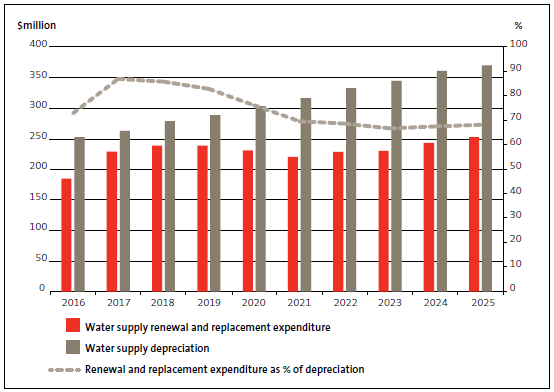
Source: Data collated by our office from information available in long-term plans.
Figure 8
Forecast renewal and replacement capital expenditure on stormwater drainage and related depreciation
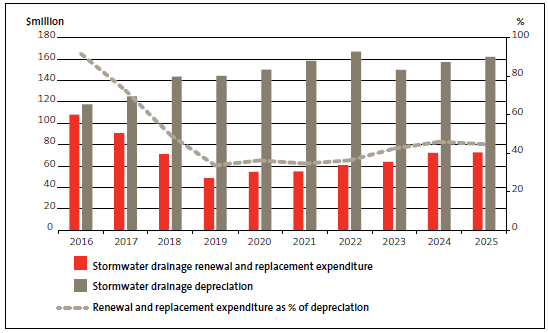
Source: Data collated by our office from information available in long-term plans.
Figure 9
Forecast renewal and replacement capital expenditure on flood protection and control works and related depreciation
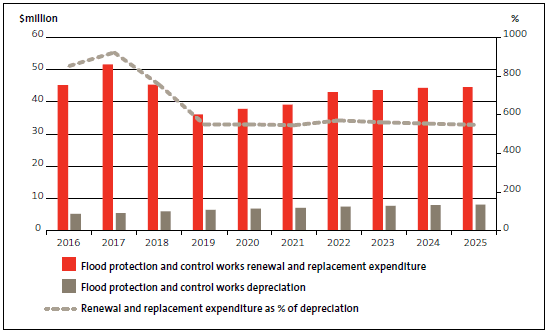
Source: Data collated by our office from information available in long-term plans.
2.15
The proportion of renewal expenditure to depreciation varies significantly across these groups. The ratio for the flood protection spending is high, because much of the spending is on land that is not depreciated. The results for roading and footpaths show renewal spending at the level that, in theory, is ideal – perhaps because these assets are managed in conjunction with the New Zealand Transport Agency and the assets have a shorter lifecycle. Renewal and replacement spending on the "three waters" asset group remains well below the level of depreciation.
2.16
As noted in our previous reports, this does not necessarily indicate that the renewal and replacement spending will be inadequate. It may be that depreciation rates established for accounting purposes do not accurately reflect actual consumption of the assets, or that the assets are in a phase of their (long) life cycles where less renewal spending is needed than will be needed later.
2.17
It is important that each local authority understand the reason for the gap between their current forecast spending on renewing and replacing assets and forecast depreciation, for each asset class.
2.18
Local authorities now have a richer set of information to help in making this assessment as a result of preparing 30-year infrastructure strategies. This knowledge is essential to enable effective planning and – more importantly – to provide assurance to the community that the local authority will be able to continue to deliver services at the expected level.
2.19
We encourage local authorities to continue looking carefully at whether the funding needed to renew and replace assets is appropriate.
Are local authorities planning reasonable and justified rates increases?
2.20
Rates revenue, on average, makes up 53.4% of local authorities' total forecast operating income of $125.9 billion over the period 2015-25. This is higher than the average for the previous LTPs, which was 52%, but remains consistent with historical actual results (53% in 2008/09, 52% in 2009/10, 54% in 2010/11, 55% in 2011/12, and 54% in 2013/14). Figure 10 shows the sources of all local authorities' income as set out in the latest LTPs.
Figure 10
Sources of all local authorities' income, 2015-25
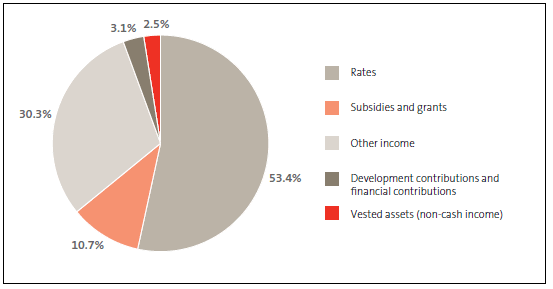
Source: Data collated by our office from information available in long-term plans.
2.21
Individually, the average proportion of income made up by rates revenue during the 10-year period varies from 5.7% (Chatham Islands Council − this local authority has about 600 residents and relies heavily on central government funding for its operational and capital expenditure) to 75.9% (Kawerau District Council). Eight local authorities have rates income that makes up less than 40% of their total income. For 20 local authorities, rates income makes up more than 70% of their income.
2.22
In their LTPs, local authorities consistently state that they want to provide affordable services to their communities. About 60% of local authorities explicitly told their communities that rates affordability (and, by implication, reasonable rates rises) was important to the LTP.
2.23
Rates revenue is forecast to increase 6% for the sector as a whole in 2015/16. The average increase in the 10-year period is 4.6%, with 2018/19 having the lowest average increase of 3.7%. This is less than the average 5% annual increase indicated in the previous LTPs. Figure 11 shows the total year-on-year rates movements forecast in the previous and latest LTPs.
2.24
Based on the issues presented to the community in some local authorities' consultation documents, the movement in rates in the first year of the LTPs might reflect local authorities "catching up" on the reduced rating income they collected in previous years. However, the specific reasons for the forecast increases will vary for each local authority.
2.25
Figure 11 shows that the movements are more significant year-on-year in the latest LTPs than the previous LTPs, but the overall trend is a similar decrease in forecast rating levels towards the end of the 10-year period.
Figure 11
Total forecast year-on-year rates movements, 2012-22 and 2015-25
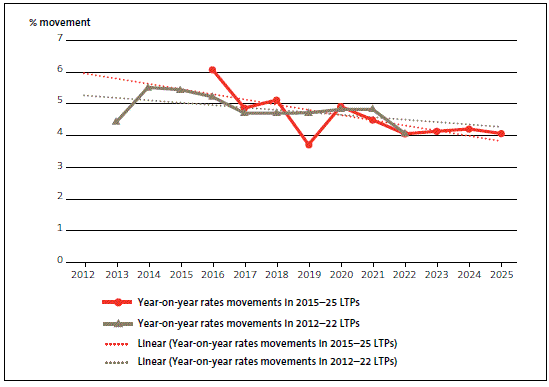
Source: Data collated by our office from information available in long-term plans.
2.26
The change in rates revenue for individual local authorities ranges from increases of more than 10% in some years to decreases of as much as 9%. Many local authorities have year-on-year movements that vary significantly, while others (such as Hamilton City Council5) have a minimal change between lowest and highest rate revenue increases. The greatest year-on-year movement is 25% for Westland District Council in 2015/16. (That increase is mostly because of a one-off rate for one ratepayer − the increase is 5% after excluding the one-off rate.)
What rates limits are local authorities imposing in the future?
2.27
Section 101A(3)(b) of the Act requires local authorities' financial strategy to include limits on rates, rate increases, and borrowing. The Act does not specify how these limits should be set, so local authorities have set limits based on their situations and the aspects of their financial situation that are most relevant to them.
2.28
Although a few local authorities set limits higher than the year-by-year increases that they have forecast, most of the limits are not substantially different to the movements forecast in the LTPs. This suggests that the limits might be restraining actual practice in setting rates. However, some local authorities have set limits well above the movements that they have forecast in their LTPs. This could bring into question the effectiveness of the limits they have set as part of their strategic financial approach.
Limit on rates
2.29
Six percent of local authorities linked their total rates limits to a percentage of their capital value, and 36% linked to a specified percentage of total revenue. Another 18% linked to a percentage movement on the previous year's budgeted revenue or expenditure, which was mainly closely aligned to their limit on rates increases.
2.30
The remaining local authorities were either unclear about what limit they used or used another mechanism to describe it, such as a maximum dollar value or maximum charge for each property. We encourage all local authorities to more clearly present this limit. Without clear disclosures, ratepayers are not able to effectively engage with their local authority about proposed limits and the local authority's strategic approach to funding.
Limit on rates increases
2.31
Half of local authorities linked their rates increase limit to the local government cost index (LGCI). Of these, most set a limit of LGCI plus a single specified percentage (ranging from 1% to 5%). Five local authorities set their rates increase limit using LGCI plus a range of up to 7%.
2.32
Most local authorities whose rates increase limit is not tied to the LGCI have a specified percentage limit or a range that was generally tied to the previous year's actual results. For those specifying a particular percentage limit, this ranged from 3% to 10%. Nine local authorities linked their rates increase limit to the consumer price index, or the consumer price index plus 1% to 4%.
Do local authorities remain focused on prudent debt management?
2.33
Many local authorities use debt to fund long-life assets. As a general principle, debt should not be used to fund operations because it is like borrowing to pay for the groceries. Furthermore, local authorities usually use debt to fund new assets to meet demand or to increase levels of service, rather than to fund renewals. However, local authorities can choose to use debt to fund any type of capital expenditure.
2.34
The total debt of the sector at 2025 is forecast to be $20 billion. This represents an increase of 34.2% from 2015.
2.35
In the previous LTPs, local authorities were forecasting total debt of $18.7 billion as at 2021/22. If we exclude Christchurch City Council's debt from the 2015-25 figures, to better compare the forecast debt movements between the previous and current LTPs, the 2021/22 balance in the current LTPs is $17.7 billion, which is $1.0 billion lower than the previous LTP debt forecast. Figure 12 shows the debt forecast in the latest LTPs compared to the previous LTPs.
2.36
Figure 12 shows that debt is forecast to continue increasing, but at a slowing rate in later years.
Figure 12
Forecast debt in the latest (including Christchurch City Council) and previous (excluding Christchurch City Council) long-term plans
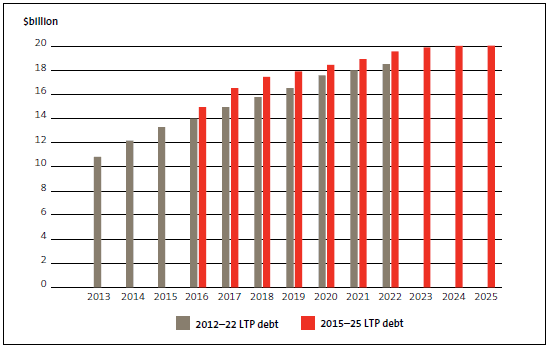
Source: Data collated by our office from information available in long-term plans.
2.37
Local authorities' total debt is significantly influenced by Auckland Council's debt, which is forecast to reach $11.6 billion by 2025 – making up 58% of the total debt. The six metropolitan local authorities6 are forecast to hold $15.6 billion or 78% of the debt of the sector. They are all included in the 10 highest debt holders at 2025, whose forecast total debt at that time is expected to be $16.7 billion. Figure 13 shows local authorities' share of forecast debt at 2025.
Figure 13
Spread of forecast debt at 2025
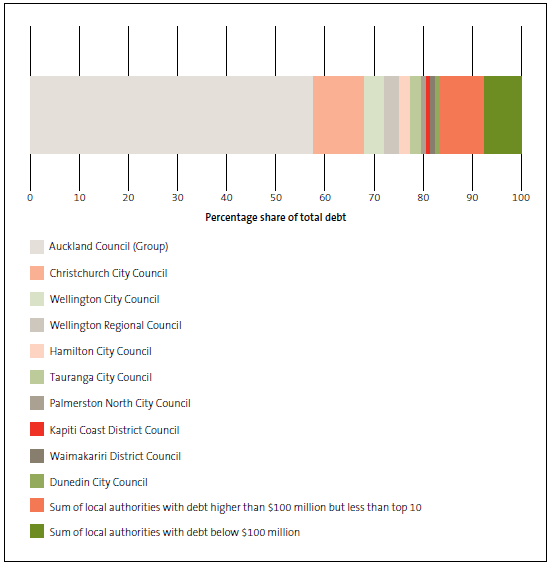
Source: Data collated by our office from information available in long-term plans.
2.38
The highest debt holders at 2025 include the local authorities facing the greatest population growth. Growth in Auckland is of an unprecedented scale, at more than 25,000 new residents a year. Christchurch City Council and Waimakariri District Council were affected by the 2010 earthquakes and are using debt to fund rebuilding work.
2.39
The exception to this correlation between local authorities' debt levels and growth is Dunedin City Council. The Council currently has significant levels of debt. It also faces a challenge in the next 30 years as it addresses its ageing infrastructure, which will require significant investment. Dunedin City Council's LTP acknowledges these issues and its financial strategy outlines how the Council is planning to address these issues, including a proposal to decrease debt levels.
2.40
Total debt for all local authorities, excluding Auckland Council, is forecast to increase by 23.2% to $8.5 billion by 2025.
2.41
About one-third of local authorities presented decreasing debt as one of their priorities in their LTP. In 2015, nine local authorities have no debt, and 11 are forecasting no debt by 2025. Three local authorities that have debt in 2015 have forecast to clear that debt by 2025, and one local authority with no debt in 2015 has forecast to have a debt balance of just under $5 million by 2025.
2.42
The largest forecast decrease in debt between 2015 and 2025 is $95.0 million for Dunedin City Council. The greatest forecast increase is $3.5 billion for Auckland Council. Thirty local authorities have forecast debt decreases and 48 have forecast increases. The range of forecast decreases is from $95.0 million to $2,000 and the range of forecast increases is from $3.5 billion to $1.8 million. Appendix 1 sets out the 2015/16 and 2024/25 forecast debt balances for all local authorities.
2.43
Three local authorities − Rangitikei, Ruapehu, and Wairoa District Councils − forecast an increase in debt and a decline in population in the 10 years of their plans. Furthermore, those districts will have an ageing population, potentially on fixed incomes. In all three situations, the population decline being forecast is small and their projected debt is within the debt limits the local authorities have set. These local authorities have had to think carefully about the financial impact on future ratepayers when preparing their LTPs. For example, Ruapehu District Council has had to think carefully about the impact of increased tourist demand on its district.
2.44
Individually, LTPs have forecast debt limits within reasonable financial parameters and expectations of income. Figure 14 shows the current levels of debt and forecast debt limits of local authorities.
Figure 14
Debt statistics (for those local authorities with debt)
| Overall sector position at 2015 | Highest at 2015 | Lowest at 2015 | Overall sector position at 2025 | Highest at 2025 | Lowest at 2025 | |
|---|---|---|---|---|---|---|
| Debt as % of operating income | 137% | 221% | 1% | 89% | 140% | 1% |
| Debt as % of assets | 11% | 26% | 1% | 11% | 26% | 1% |
| Debt as % of rates income | 273% | 469% | 1% | 249% | 440% | 3% |
| Debt as % of equity | 13.0% | 35.8% | 0.05% | 13.0% | 40.8% | 0.13% |
Source: Data collated by our office from information available in long-term plans.
Did local authorities set effective limits on their forecast debt levels?
2.45
We extracted from local authorities' 2015-25 financial strategies the borrowing limits that they have set. It is clear that many limits have been set "generously" and practices vary between local authorities.
2.46
Many limits have been set far above the actual position forecast in the LTP. Some local authorities might have adopted the New Zealand Local Government Funding Agency (LGFA) limits without considering how well they fit their own situation. Others might have allowed fiscal "headroom" to allow for resilience in its financial strategy. We encourage local authorities to consider whether the limits they set are a strategic control on financial practice. We continue to support the Society of Local Government Managers' good practice guidance about the importance of developing financial strategies, and the limits included in them, from both a top-down (strategic and policy) basis and a bottom-up (actual financial position) basis.
2.47
The most widely used limits are those required by the LGFA and then a range of other limits are used by fewer local authorities. Local authorities have set between one and six borrowing limits. Figure 15 shows the range of local authorities' borrowing limits.
Figure 15
Range of local authorities' borrowing limits
| Limit | Highest in limit range | Lowest in limit range | Average limit | Number of local authorities using this limit |
|---|---|---|---|---|
| Interest as % of operating income | 25% | 6.25% | 13% | 48 |
| Interest as % of rates income | 40% | 7.5% | 21% | 30 |
| Debt as % of operating income | 275% | 50% | 162% | 45 |
| Minimum liquidity ratio | 170% | 100% | 113% | 9 |
| Debt as % of assets | 20% | 10% | 16% | 8 |
| Maximum debt per capita or rateable property | $5,788 | $500 | $2,782 | 12 |
| Debt as % of rates revenue | 200% | 25% | 106% | 6 |
| Debt as % of equity | 28% | 5% | 17.5% | 8 |
| Interest costs as a multiple of cash inflows from operations | 5 times | 0.5 times | 1 time | 4 |
| Maximum total debt | $590 million | $12 million | $181 million | 10 |
Source: Data collated by our office from information available in long-term plans.
What else are local authorities telling their communities?
Other assets
2.48
Local authorities forecast that, by 2025, they will hold $3.4 billion in cash and financial assets and $5.1 billion of investments in council-controlled organisations, council-controlled trading organisations, and other entities. These balances are forecast to increase by 27% and 6% respectively between 2015 and 2025.
2.49
The increased cash and financial asset holdings might be linked to local authorities' ratings for future renewal and asset replacements based on depreciation and the fact that current spending on this type of capital expenditure is below current depreciation levels. However, it is not clear whether this is the explanation for the growing balance. We will continue to monitor this.
Fees and charges
2.50
Fees and charges make up 91% of local authorities' other income (see Figure 10). Among the activities that attract fees and charges are building and resource consenting processes, facilities hire and entry fees, dog licensing, and food premises licensing.
2.51
Fees and charges might increase in future years where pressure increases for local authorities to reduce the proportion of income sourced from rates. This could take place particularly if there is pressure to reduce the impact of rates rises on fixed-income households.
2.52
The total revenue forecast to come from fees and charges between 2015 and 2025 is $32 billion. The fees and charges collected by local authorities are forecast to increase by 51.4% between 2015 and 2025. Although much of this forecast increase reflects the effects of inflation, fees and charges are increasing and are likely to continue to.
1: All local authorities except Auckland Council prepared an LTP that included council-only financial forecasts. Auckland Council chose to prepare an LTP that covers the Council and its group of council-controlled organisations. Auckland Council's group financial forecasts are significant and are included in this analysis.
2: The expenditure included in the LTPs is adjusted for inflation.
3: Based on the capital expenditure information included in the whole-of-council funding impact statements.
4: See Part 2 of our 2014 report, Water and Roads: Funding and management challenges, available on our website.
5: Hamilton City Council has a range of 0.48% between its lowest and highest rate revenue increase.
6: We have defined the metropolitan local authorities as Auckland Council, Tauranga City Council, Hamilton City Council, Wellington City Council, Christchurch City Council, and Dunedin City Council.

